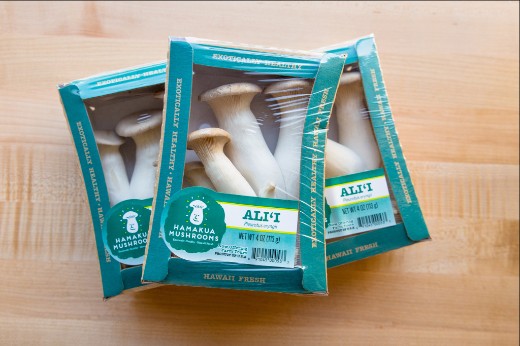In Good Light: “When you think of mushrooms, you usually think of something growing in a dark place, with lots of dirt and smelly, decomposing material,” says Janet. “But I call ours ‘enlightened mushrooms.’” They are grown in a pristine, bright room — equipped with skylights and artificial grow lights — in a special mix of wood, wheat bran and corn and “it smells like baking bread!”
Forget the Bath! According to Janet, “Mushrooms are like sponges.” It’s best to just wipe them lightly with a barely damp towel and never wash them! Any dirt-like crumbly bits you might see are the wood mix the mushrooms feed on — simply brush it off or cut it away.
What’s the Fuzz? Don’t panic if you notice a fine white fuzz in your box of Hamakua Aliʻi Mushroooms. “We get calls all the time,” laughs Janice. Once removed from their chilly growing environment, the extremely temperature-sensitive mushrooms — which are still alive when harvested — release their spores, which rapidly grow into white fuzz called mycelium. The good news is that it’s safe and absolutely edible.
Trade Secret: “Most people don’t cook mushrooms correctly,” Janice shares. “When you sauté them, the secret is a very hot pan. If the pan isn’t hot enough when they go in, you’re just steaming them, and they absorb all the oil and you get oily mushrooms. She also advised saving the seasoning until the end: “Salting them early makes them release all their water, so you end up with boiled mushrooms.”
Hail to the King: Also known as king oysters, trumpet or eryngii, Hamakua Mushrooms’ signature Aliʻi mushrooms are large and meaty with a slightly sweet and nutty flavor that some say reminds them of abalone. Hardy, with a firm texture, they stand up well to sautéing, braising, broiling or grilling and last one to two weeks in the refrigerator.


